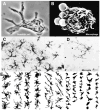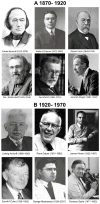Mononuclear Phagocytes, Cellular Immunity, and Nobel Prizes: A Historic Perspective
- PMID: 39195266
- PMCID: PMC11352343
- DOI: 10.3390/cells13161378
Mononuclear Phagocytes, Cellular Immunity, and Nobel Prizes: A Historic Perspective
Abstract
The mononuclear phagocyte system includes monocytes, macrophages, some dendritic cells, and multinuclear giant cells. These cell populations display marked heterogeneity depending on their differentiation from embryonic and bone marrow hematopoietic progenitors, tissue location, and activation. They contribute to tissue homeostasis by interacting with local and systemic immune and non-immune cells through trophic, clearance, and cytocidal functions. During evolution, they contributed to the innate host defense before effector mechanisms of specific adaptive immunity emerged. Mouse macrophages appear at mid-gestation and are distributed throughout the embryo to facilitate organogenesis and clear cells undergoing programmed cell death. Yolk sac, AGM, and fetal liver-derived tissue-resident macrophages persist throughout postnatal and adult life, supplemented by bone marrow-derived blood monocytes, as required after injury and infection. Nobel awards to Elie Metchnikoff and Paul Ehrlich in 1908 drew attention to cellular phagocytic and humoral immunity, respectively. In 2011, prizes were awarded to Jules Hoffmann and Bruce Beutler for contributions to innate immunity and to Ralph Steinman for the discovery of dendritic cells and their role in antigen presentation to T lymphocytes. We trace milestones in the history of mononuclear phagocyte research from the perspective of Nobel awards bearing directly and indirectly on their role in cellular immunity.
Keywords: Nobel prizes; dendritic cells; history; homeostasis; immunity; macrophages; mononuclear phagocyte system; multinucleated giant cells; phagocytosis; plasma membrane receptors.
Conflict of interest statement
The authors declare no conflicts of interest.
Figures









Similar articles
-
Using Experience Sampling Methodology to Capture Disclosure Opportunities for Autistic Adults.Autism Adulthood. 2023 Dec 1;5(4):389-400. doi: 10.1089/aut.2022.0090. Epub 2023 Dec 12. Autism Adulthood. 2023. PMID: 38116059 Free PMC article.
-
Falls prevention interventions for community-dwelling older adults: systematic review and meta-analysis of benefits, harms, and patient values and preferences.Syst Rev. 2024 Nov 26;13(1):289. doi: 10.1186/s13643-024-02681-3. Syst Rev. 2024. PMID: 39593159 Free PMC article.
-
Depressing time: Waiting, melancholia, and the psychoanalytic practice of care.In: Kirtsoglou E, Simpson B, editors. The Time of Anthropology: Studies of Contemporary Chronopolitics. Abingdon: Routledge; 2020. Chapter 5. In: Kirtsoglou E, Simpson B, editors. The Time of Anthropology: Studies of Contemporary Chronopolitics. Abingdon: Routledge; 2020. Chapter 5. PMID: 36137063 Free Books & Documents. Review.
-
Defining the optimum strategy for identifying adults and children with coeliac disease: systematic review and economic modelling.Health Technol Assess. 2022 Oct;26(44):1-310. doi: 10.3310/ZUCE8371. Health Technol Assess. 2022. PMID: 36321689 Free PMC article.
-
Trends in Surgical and Nonsurgical Aesthetic Procedures: A 14-Year Analysis of the International Society of Aesthetic Plastic Surgery-ISAPS.Aesthetic Plast Surg. 2024 Oct;48(20):4217-4227. doi: 10.1007/s00266-024-04260-2. Epub 2024 Aug 5. Aesthetic Plast Surg. 2024. PMID: 39103642 Review.
References
-
- Darwin C., Beer G. On the Origin of Species. OUP Oxford; Oxford, UK: 2008.
-
- Harris H. The Birth of the Cell. Yale University Press; New Haven, CT, USA: 2000.
-
- Meyer H., Ackerknecht E.H. Rudolf Virchow: Doctor, Statesman, Anthropologist. Books Abroad. 1955;29:358. doi: 10.2307/40094696. - DOI
-
- Brock T.D., Geison G.L., Dubos R.J. Pasteur and Modern Science. Springer; Berlin/Heidelberg, Germany: 2014.
-
- Bernard C. An Introduction to the Study of Experimental Medicine. 1865. [(accessed on 11 August 2024)]. Available online: https://www.britannica.com/topic/An-Introduction-to-the-Study-of-Experim....
Publication types
MeSH terms
Grants and funding
LinkOut - more resources
Full Text Sources

